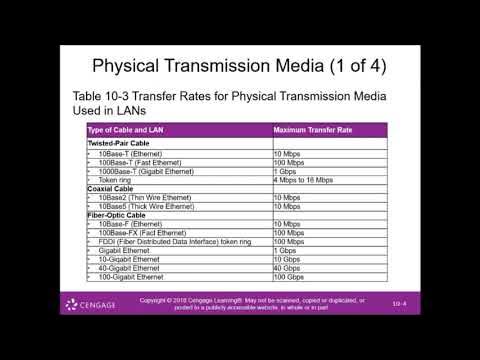Cat Ethernet Cable Comparison [Cybersecurity | Skill: Skilled]
Summary
TLDRThis video discusses the evolution of Ethernet cables, from Cat5 to Cat9, highlighting their increasing data transmission speeds and bandwidth capacities. Cat5 is becoming obsolete, replaced by Cat5e, which offers 1 Gbps speeds. Cat6 provides 1 Gbps at 250 MHz, while Cat7 supports 10 Gbps at 600 MHz. Cat8 cables deliver 25 Gbps at 2 GHz, representing the latest technology. Shielding in Cat6-8 protects against interference, and Cat5e can be shielded or unshielded. The video also mentions higher-performing variants like Cat6A and Cat7A.
Takeaways
- 🔢 **Cat Categorization**: Ethernet cables are categorized as Cat 5, Cat 6, Cat 7, Cat 8, and Cat 9, with each higher number indicating an upgrade in performance.
- 🚀 **Speed Improvement**: Higher category cables support faster data transmission speeds.
- 🌐 **Max Bandwidth**: The maximum bandwidth capacity increases with the category number, allowing more data to be transmitted.
- 📈 **Cat5 Obsolescence**: Cat5 is becoming obsolete, being replaced by the improved Cat5e.
- 💾 **Cat5e Advancement**: Cat5e supports up to 1 gigabit per second and maintains a 100 megahertz bandwidth, offering a cost-effective upgrade.
- 🚀 **Cat6 Performance**: Cat6 cables provide a significant upgrade with 1 gigabit per second speeds and a 250 megahertz bandwidth.
- 💰 **Cat7 Data Rates**: Cat7 cables offer data rates up to 10 gigabits per second with a 600 megahertz bandwidth, at a moderate cost.
- 🏎️ **Cat8 Speed**: Cat8 cables are the fastest, offering 25 gigabits per second at a 2 gigahertz bandwidth, but come with a higher price.
- 🛡️ **Shielding**: Cables from Cat 6 to Cat 8 typically have shielding to protect against electronic interference, while Cat 5 and Cat 5e can be shielded or unshielded.
- 📈 **Upgraded Versions**: There are improved versions like Cat6A and Cat7A with better specifications than their original counterparts.
Q & A
What is the main purpose of the different categories of Ethernet cables?
-The main purpose of the different categories of Ethernet cables is to differentiate between types of cables used for various speed or network standards, data transmission speeds, and maximum bandwidth capacities.
How does the category number of an Ethernet cable relate to its performance?
-The higher the category number of an Ethernet cable, the higher its data transmission speed and maximum bandwidth capacity, which generally means better performance.
What is the maximum data transmission speed and bandwidth capacity of CAT5 Ethernet cables?
-CAT5 Ethernet cables provide connections up to 100 megabits per second at a 100 megahertz maximum bandwidth capacity.
Why is CAT5 becoming obsolete and what is replacing it?
-CAT5 is becoming obsolete because it is an older standard with lower performance capabilities. It is being replaced by the upgraded CAT5e, which offers higher speeds and better performance.
What is the difference between CAT5e and CAT6 Ethernet cables in terms of speed and bandwidth?
-CAT5e can reach up to 1 gigabit per second, while CAT6 has a maximum bandwidth of 250 megahertz and can also support up to 1 gigabit per second.
What are the data rates and bandwidth capacity of CAT7 Ethernet cables?
-CAT7 Ethernet cables offer data rates of up to 10 gigabits per second at a 600 megahertz bandwidth capacity.
How does CAT8 compare to other categories in terms of data transmission and bandwidth?
-CAT8 cables provide data transmissions of up to 25 gigabits per second at a bandwidth capacity of 2 gigahertz, making it the highest performing category mentioned.
What is the difference between shielded and unshielded Ethernet cables?
-Shielded Ethernet cables help protect data from outside electronic interferences, while unshielded cables do not offer this protection.
Which categories of Ethernet cables have shielding, and which can be both shielded and unshielded?
-CAT6 through CAT8 have shielding. CAT5 or CAT5e can be both shielded and unshielded.
Are there any upgraded versions of the mentioned Ethernet cable categories, and what are they?
-Yes, the upgraded versions mentioned are CAT6A and CAT7A, which have improved specifications compared to their original counterparts.
What is the cost implication of the different Ethernet cable categories?
-Generally, as the category number increases, the cost also increases due to better performance and the latest technology, with CAT8 being the most expensive.
Outlines

This section is available to paid users only. Please upgrade to access this part.
Upgrade NowMindmap

This section is available to paid users only. Please upgrade to access this part.
Upgrade NowKeywords

This section is available to paid users only. Please upgrade to access this part.
Upgrade NowHighlights

This section is available to paid users only. Please upgrade to access this part.
Upgrade NowTranscripts

This section is available to paid users only. Please upgrade to access this part.
Upgrade NowBrowse More Related Video

Cours réseau | Le câblage

Lec-9: Types Of Cables in Computer Networks | Coaxial, twisted pair, fibre optic cable

Internet Hardware

How Fiber Optics Works 🌎

Module 10 Communicating Digital Content Wired and Wireless Networks and Devices PART5

Free CCNA | Interfaces and Cables | Day 2 | CCNA 200-301 Complete Course
5.0 / 5 (0 votes)